remove seats MAZDA MODEL 3 HATCHBACK 2018 Owners Manual (in English)
[x] Cancel search | Manufacturer: MAZDA, Model Year: 2018, Model line: MODEL 3 HATCHBACK, Model: MAZDA MODEL 3 HATCHBACK 2018Pages: 624, PDF Size: 61.21 MB
Page 16 of 624
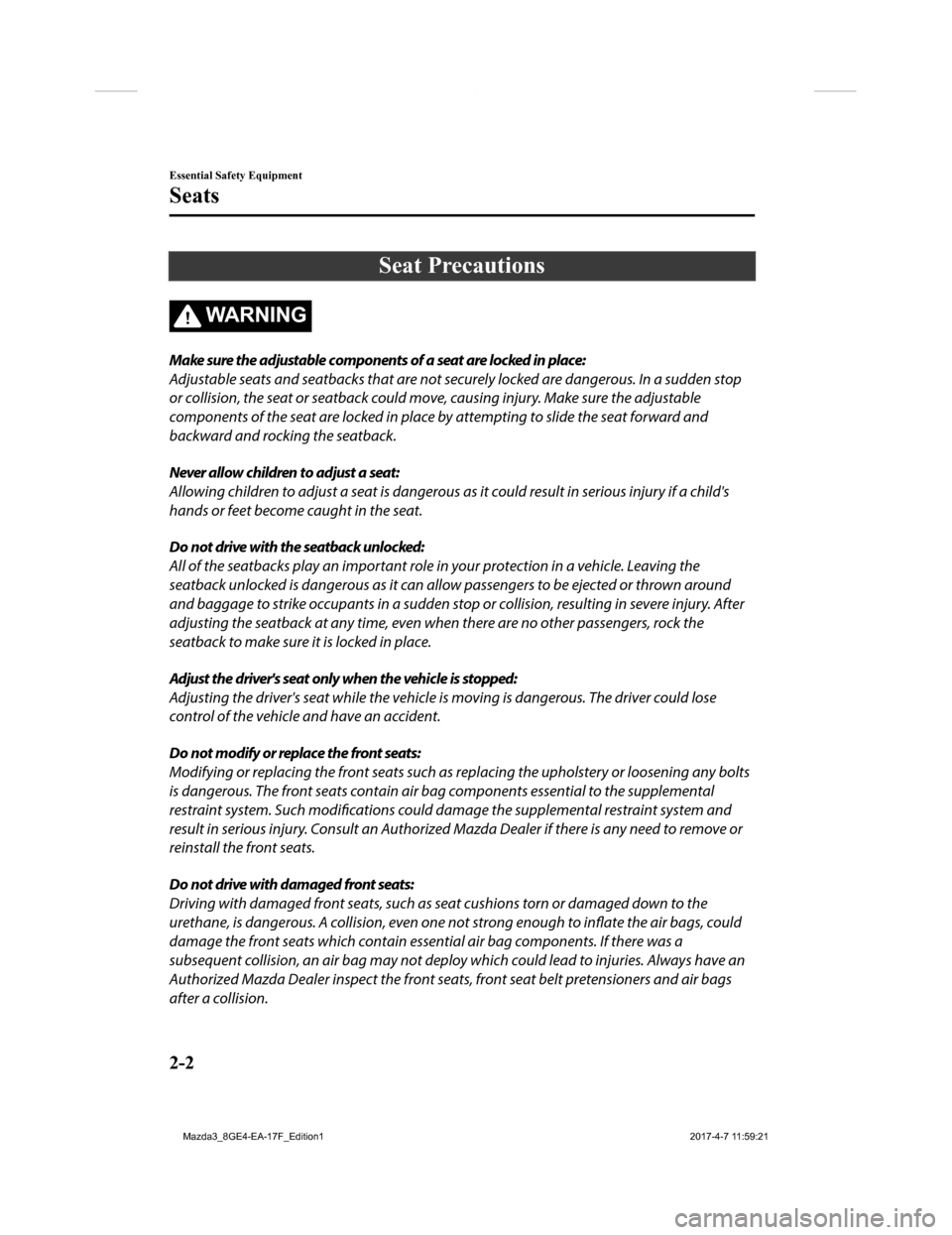
Seat Precautions
WA R N I N G
Make sure the adjustable components of a seat are locked in place:
Adjustable seats and seatbacks that are not securely locked are dangerous. In a sudden stop
or collision, the seat or seatback could move, causing injury. Make sure the adjustable
components of the seat are locked in place by attempting to slide the seat forward and
backward and rocking the seatback.
Never allow children to adjust a seat:
Allowing children to adjust a seat is dangerous as it could result in serious injury if a child's
hands or feet become caught in the seat.
Do not drive with the seatback unlocked:
All of the seatbacks play an important role in your protection in a vehicle. Leaving the
seatback unlocked is dangerous as it can a llow passengers to be ejected or thrown around
and baggage to strike occupants in a sudden stop or collision, resulting in severe injury. After
adjusting the seatback at any time, even when there are no other passengers, rock the
seatback to make sure it is locked in place.
Adjust the driver's seat only when the vehicle is stopped:
Adjusting the driver's seat while the vehicle is moving is dangerous. The driver could lose
control of the vehicle and have an accident.
Do not modify or replace the front seats:
Modifying or replacing the front seats such as replacing the upholstery or loosening any bolts
is dangerous. The front seats contain air ba g components essential to the supplemental
restraint system. Such modifications could damage the supplemental restraint system and
result in serious injury. Consul t an Authorized Mazda Dealer if there is any need to remove or
reinstall the front seats.
Do not drive with damaged front seats:
Driving with damaged front seats, such as seat cushions torn or damaged down to the
urethane, is dangerous. A collision, even one not strong enough to inflate the air bags, could
damage the front seats which contain essential air bag components. If there was a
subsequent collision, an air bag may not deploy which could lead to injuries. Always have an
Authorized Mazda Dealer inspect the front seats, front seat belt pretensioners and air bags
after a collision.
Essential Safety Equipment
Seats
2-2
Mazda3_8GE4-EA-17F_Edition1 2017-4-7 11:59:21
Page 22 of 624

When transporting cargo, do not allow the
cargo to exceed the height of the
seatback(s).
Transporting cargo stacked higher than the
seatback(s) is dangerous as visibility to the
rear and sides of the vehicle is reduced
which could interfere with driving
operations and lead to an accident.
Lowering the seatback(s)
CAUTION
Check the position of a front seat before
folding a rear seatback.
Depending on the position of a front seat, it
may not be possible to fold a rear seatback
all the way down because it may hit the
seatback of the front seat which could
scratch or damage the front seat or its
pocket. Lower or remove the head restraint
on the rear outboard seat if necessary.
(4–Door)
1.(Split-folding type seat)
Open the trunk lid and pull the lever of
the seatback you want to fold down.
(One-piece folding type seat)
Open the trunk lid and pull the lever of
the seatback.
*1: With split-folding
type seat only *1
2. Open a rear door and fold the rear seat
forward.
(5–Door)
Press the push knob to fold down the
seatback.
To return the seatback to its upright
position:
WA R N I N G
When returning a seatback to its upright
position, make sure the 3-point seat belt is
not caught in the seatback and the 3-point
seat belt is not twisted.
If the seat belt is used while it is twisted and
caught in the seatback, the seat belt
cannot function at its full capacity, which
could cause serious injury or death.
Essential Safety Equipment
Seats
2-8
Mazda3_8GE4-EA-17F_Edition1 2017-4-7 11:59:21
Page 24 of 624

Head Restraints
Your vehicle is equipped with head
restraints on all outboard seats and the rear
center seat. The head restraints are
intended to help protect you and the
passengers from neck injury.
WA R N I N G
Always drive with the head restraints
installed when seats are being used and
make sure they are properly adjusted:
Driving with the head restraints adjusted
too low or removed is dangerous. With no
support behind your head, your neck could
be seriously injured in a collision.
Height adjustment
To raise a head restraint, pull it up to the
desired position.
To lower the head restraint, press the
stop-catch release, then push the head
restraint down.
Adjust the head restra int so that the center
is even with the top of the passenger's
ears.
Front outboard seat
Rear outboard seat
Rear center seat
Essential Safety Equipment
Seats
2-10
Mazda3_8GE4-EA-17F_Edition1 2017-4-7 11:59:21
Page 25 of 624
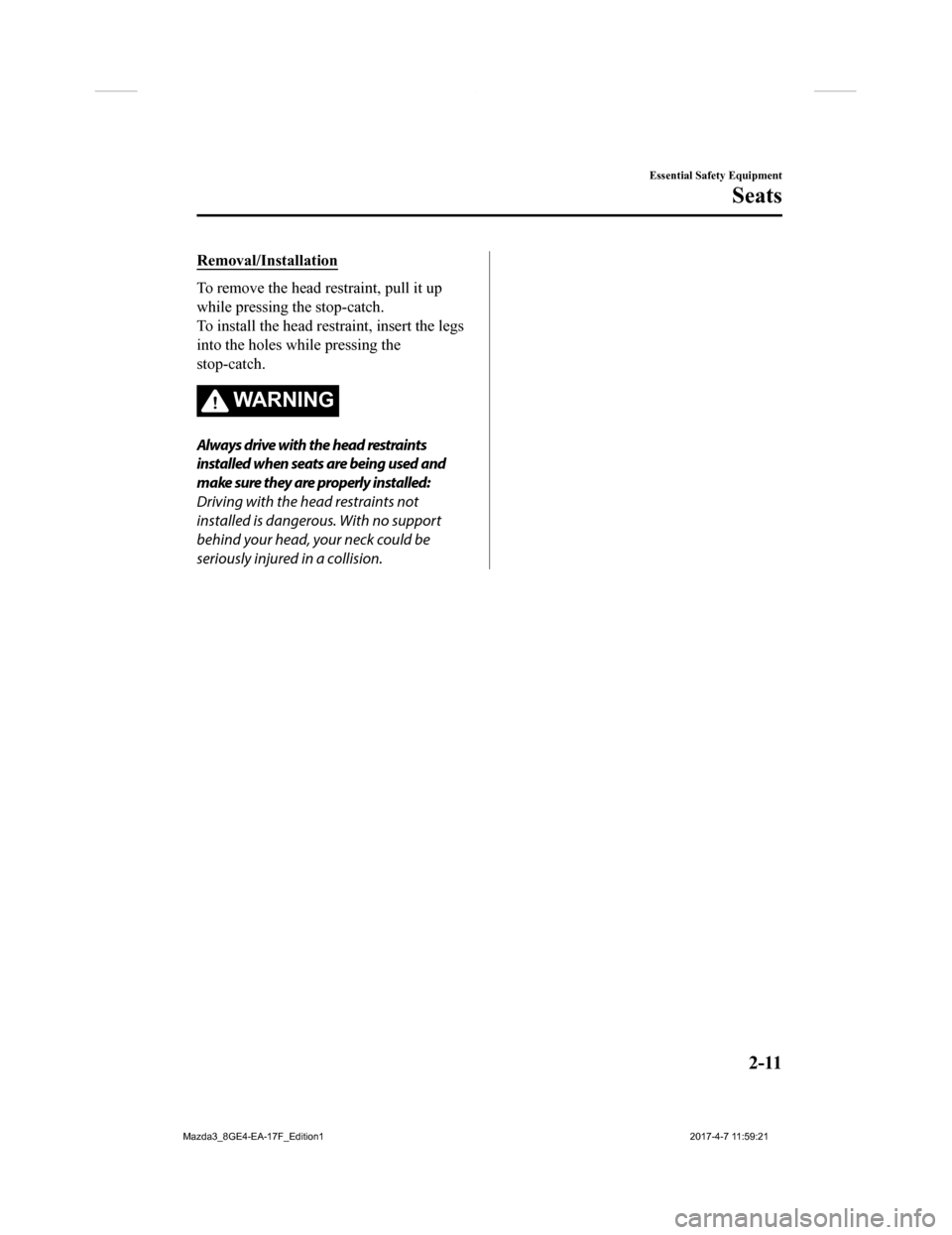
Removal/Installation
To remove the head restraint, pull it up
while pressing the stop-catch.
To install the head restraint, insert the legs
into the holes while pressing the
stop-catch.
WA R N I N G
Always drive with the head restraints
installed when seats are being used and
make sure they are properly installed:
Driving with the head restraints not
installed is dangerous. With no support
behind your head, your neck could be
seriously injured in a collision.
Essential Safety Equipment
Seats
2-11
Mazda3_8GE4-EA-17F_Edition1 2017-4-7 11:59:21
Page 26 of 624
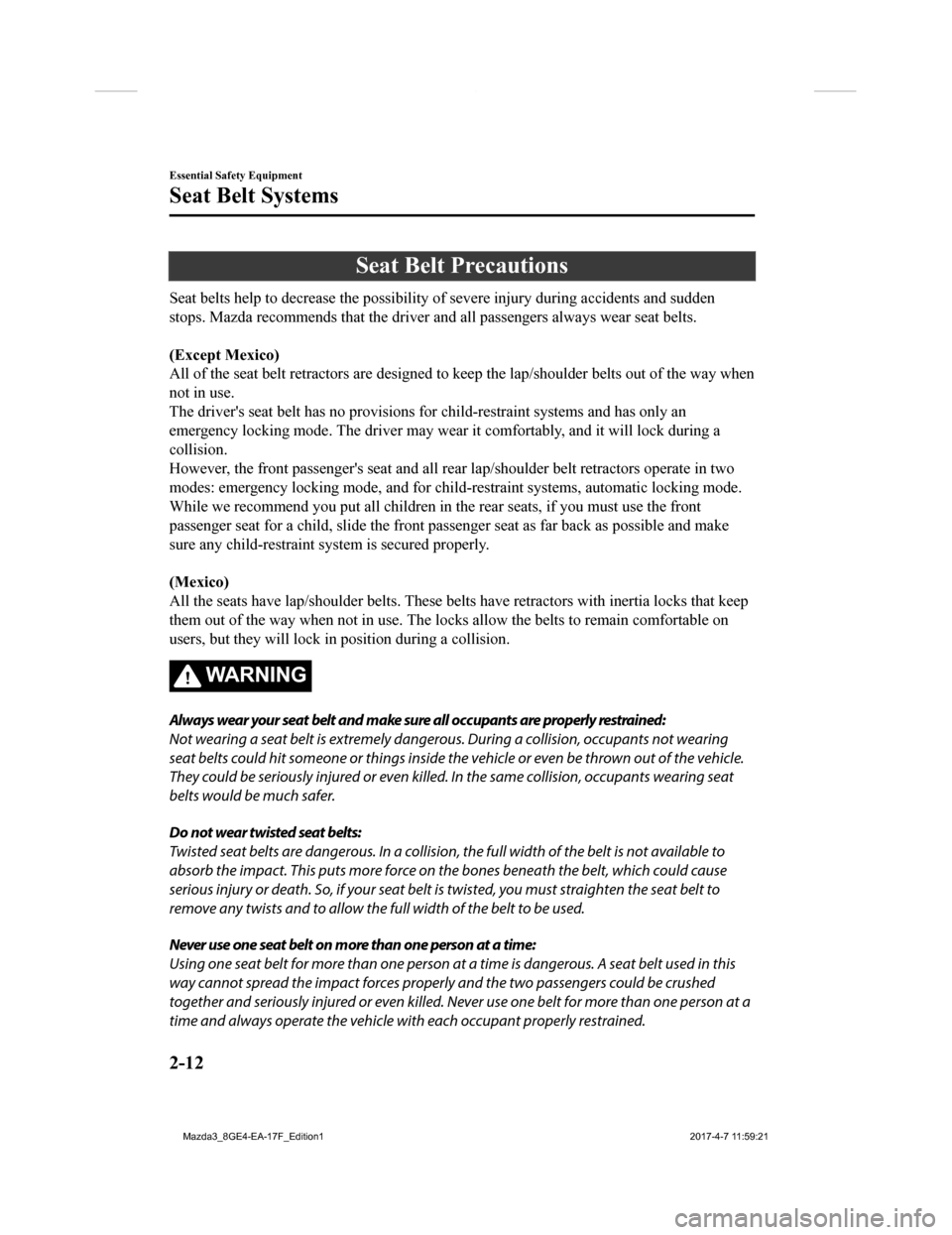
Seat Belt Precautions
Seat belts help to decrease the possibility of severe injury during accidents and sudden
stops. Mazda recommends that the driver and all passengers always wear seat belts.
(Except Mexico)
All of the seat belt retractors are designed to keep the lap/sh oulder belts out of the way when
not in use.
The driver's seat belt has no provisions for child-restraint sy stems and has only an
emergency locking mode. The driver may wear it comfortably, and it will lock during a
collision.
However, the front passenger's seat and all rear lap/shoulder b elt retractors operate in two
modes: emergency locking mode, and for child-restraint systems, automatic locking mode.
While we recommend you put all chi ldren in the rear seats, if you must use the front
passenger seat for a child, slide the front passenger seat as f ar back as possible and make
sure any child-restraint sy stem is secured properly.
(Mexico)
All the seats have lap/shoulder belts. These belts have retract ors with inertia locks that keep
them out of the way when not in use. The locks allow the belts to remain comfortable on
users, but they will lock in position during a collision.
WA R N I N G
Always wear your seat belt and make sure all occupants are properly restrained:
Not wearing a seat belt is extremely dangerou s. During a collision, occupants not wearing
seat belts could hit someone or things inside th e vehicle or even be thrown out of the vehicle.
They could be seriously injured or even killed . In the same collision, occupants wearing seat
belts would be much safer.
Do not wear twisted seat belts:
Twisted seat belts are dangerous. In a collision, the full width of the belt is not available to
absorb the impact. This puts more force on the bones beneath the belt, which could cause
serious injury or death. So, if your seat belt is twisted, you must straighten the seat belt to
remove any twists and to allow the full width of the belt to be used.
Never use one seat belt on more than one person at a time:
Using one seat belt for more than one person at a time is dangerous. A seat belt used in this
way cannot spread the impact forces properly and the two passengers could be crushed
together and seriously injured or even killed. Never use one belt for more than one person at a
time and always operate the vehicle with each occupant properly restrained.
Essential Safety Equipment
Seat Belt Systems
2-12
Mazda3_8GE4-EA-17F_Edition1 2017-4-7 11:59:21
Page 54 of 624

▼Using LATCH Lower Anchor
Your Mazda is equipped with LATCH lower anchors for attachment
of specially designed
LATCH child-restraint systems in the rear seats. Both anchors m ust be used, otherwise the
seat will bounce around and put the child in danger. Most LATCH child-restraint systems
must also be used in conjunction with a tether to be effective. If they have a tether you must
use it to better assure your child's safety.
WA R N I N G
Follow the manufacturer's instructions for the use of the child-restraint system:
An unsecured child-restraint system is dangerous. In a sudden stop or a collision it could move
causing serious injury or death to the child or other occupants. Make sure the child-restraint
system is properly secured in place according to the child-restraint system manufacturer's
instructions.
Never attach two child-restraint systems to the same LATCH lower anchor:
Attaching two child-restraint systems to the sa me LATCH lower anchor is dangerous. In a
collision, one anchor may not be strong enough to hold two child-restraint system
attachments, and it may break, causing serious injury or death. If you use the seat position for
another child-restraint system when an outboard LATCH position is occupied, use the center
seat belts instead, and the tether if tether-equipped.
Make sure the child-restraint system is properly secured:
An unsecured child-restraint system is dangerous. In a sudden stop or a collision it could move
causing serious injury or death to the child or other occupants. Follow the child-restraint
system manufacturer's instructions on belt routing to secure the seat just as you would with a
child in it so that nobody is tempted to put a child in an improperly secured seat later on.
When not in use, remove it from the vehicle or fasten it with a seat belt, or latch it down to
BOTH LATCH lower anchors for LATCH child-restraint systems.
Make sure there are no seat belts or foreign objects near or around the LATCH child-restraint
system:
Not following the child-restraint system manufacturer's instructions when installing the
child-restraint system is dangerous. If seat belts or a foreign object prevent the child-restraint
system from being securely attached to the LATCH lower anchors and the child-restraint
system is installed improperly, the child-restraint system could move in a sudden stop or
collision causing serious injury or death to the child or other occupants. When installing the
child-restraint system, make sure there are no seat belts or foreign objects near or around the
LATCH lower anchors. Always follow the child-restraint system manufacturer's instructions.
Essential Safety Equipment
Child-Restraint
2-40
Mazda3_8GE4-EA-17F_Edition1 2017-4-7 11:59:21
Page 55 of 624
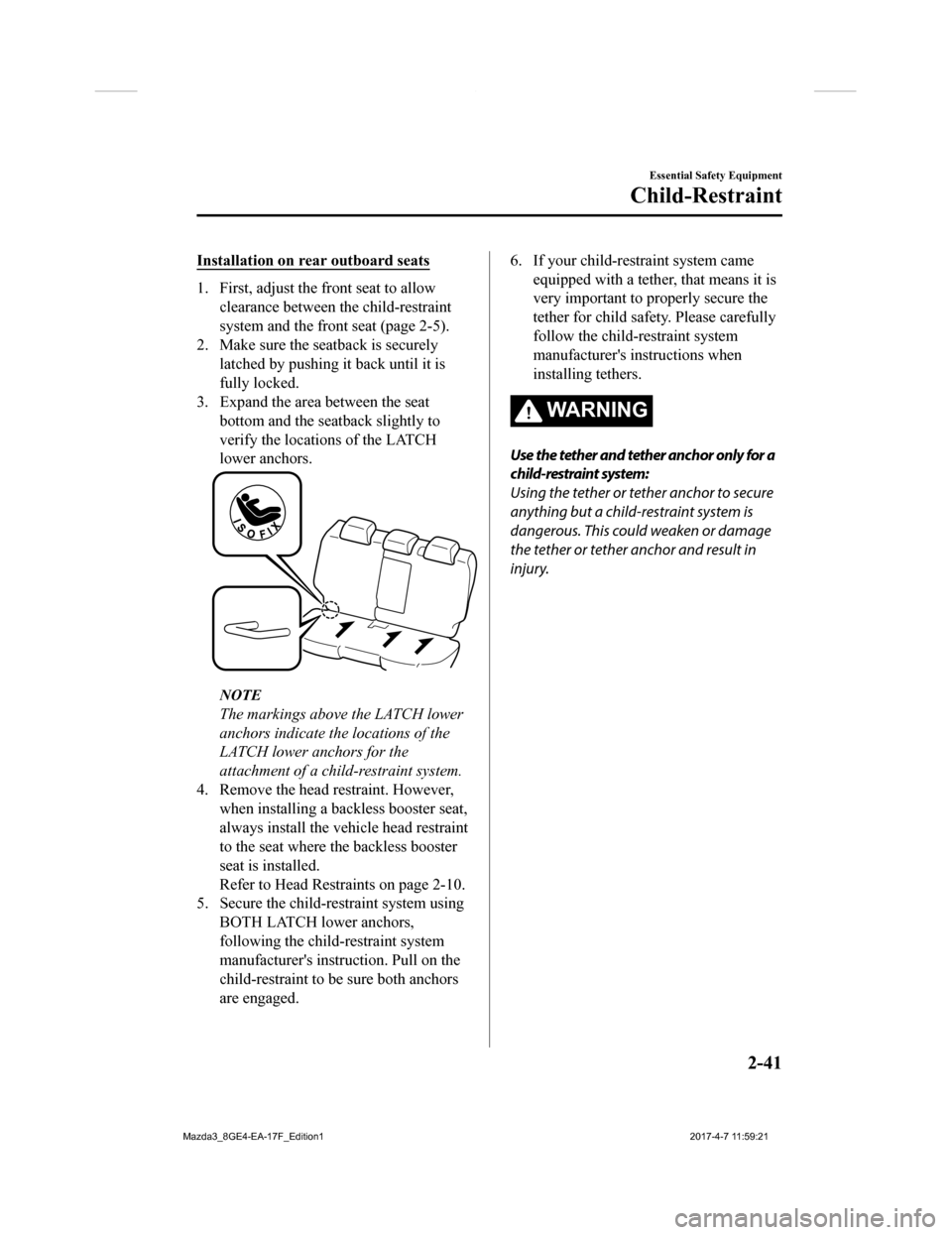
Installation on rear outboard seats
1. First, adjust the front seat to allowclearance between the child-restraint
system and the front seat (page 2-5).
2. Make sure the seatback is securely
latched by pushing it back until it is
fully locked.
3. Expand the area between the seat
bottom and the seatback slightly to
verify the locations of the LATCH
lower anchors.
NOTE
The markings above the LATCH lower
anchors indicate the locations of the
LATCH lower anchors for the
attachment of a child-restraint system.
4. Remove the head restraint. However, when installing a backless booster seat,
always install the vehicle head restraint
to the seat where the backless booster
seat is installed.
Refer to Head Restraints on page 2-10.
5. Secure the child-restraint system using
BOTH LATCH lower anchors,
following the child-restraint system
manufacturer's instruction. Pull on the
child-restraint to be sure both anchors
are engaged.
6. If your child-restraint system cameequipped with a teth er, that means it is
very important to properly secure the
tether for child safety. Please carefully
follow the child -restraint system
manufacturer's instructions when
installing tethers.
WA R N I N G
Use the tether and tether anchor only for a
child-restraint system:
Using the tether or tether anchor to secure
anything but a child-restraint system is
dangerous. This could weaken or damage
the tether or tether anchor and result in
injury.
Essential Safety Equipment
Child-Restraint
2-41
Mazda3_8GE4-EA-17F_Edition1 2017-4-7 11:59:21
Page 56 of 624
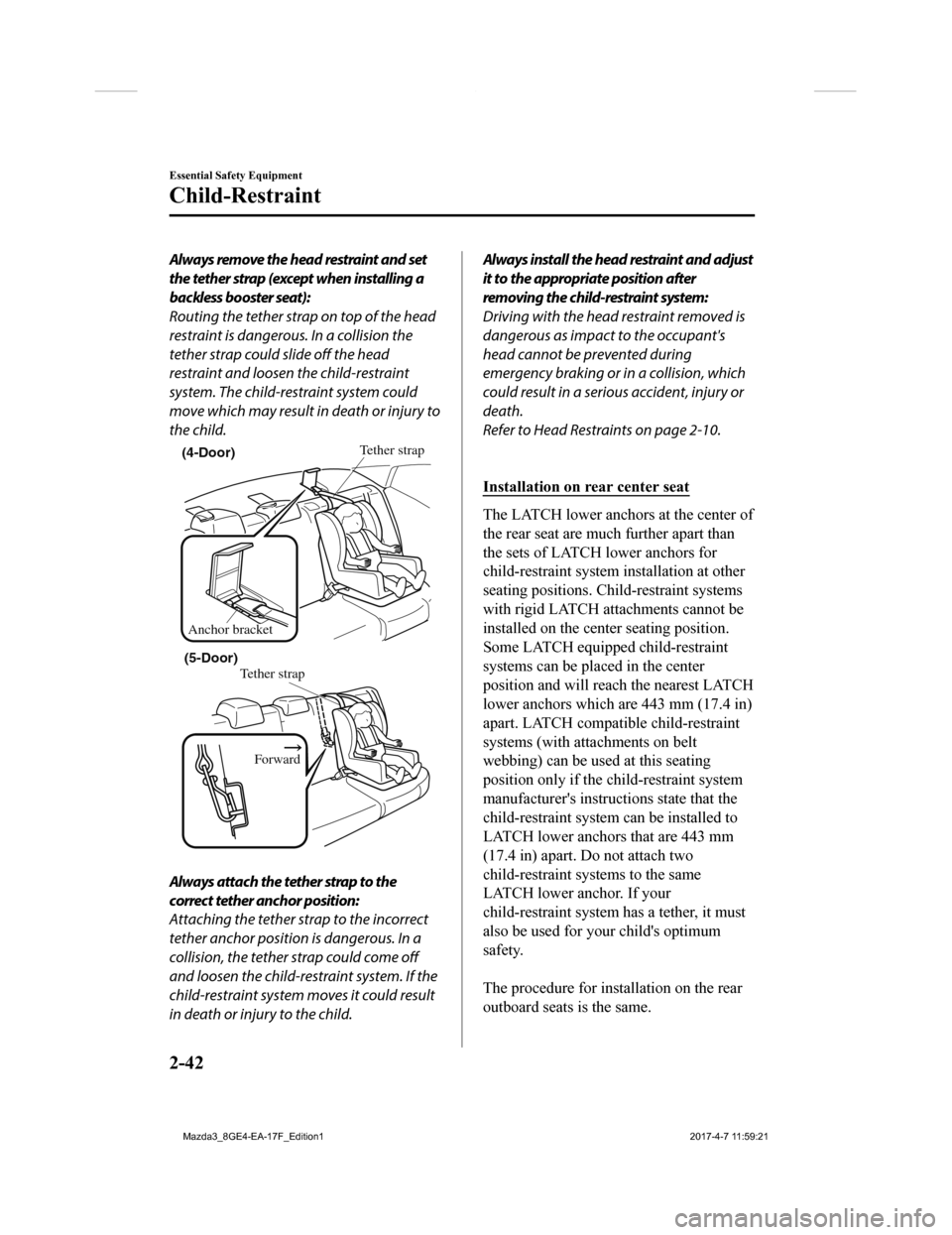
Always remove the head restraint and set
the tether strap (except when installing a
backless booster seat):
Routing the tether strap on top of the head
restraint is dangerous. In a collision the
tether strap could slide off the head
restraint and loosen the child-restraint
system. The child-restraint system could
move which may result in death or injury to
the child.
Anchor bracket
Tether strap(4-Door)
Tether strapForward
(5-Door)
Always attach the tether strap to the
correct tether anchor position:
Attaching the tether strap to the incorrect
tether anchor position is dangerous. In a
collision, the tether strap could come off
and loosen the child-restraint system. If the
child-restraint system moves it could result
in death or injury to the child.
Always install the head restraint and adjust
it to the appropriate position after
removing the child-restraint system:
Driving with the head restraint removed is
dangerous as impact to the occupant's
head cannot be prevented during
emergency braking or in a collision, which
could result in a serious accident, injury or
death.
Refer to Head Restraints on page 2-10.
Installation on rear center seat
The LATCH lower anchors at the center of
the rear seat are much further apart than
the sets of LATCH lower anchors for
child-restraint system installation at other
seating positions. Child-restraint systems
with rigid LATCH attachments cannot be
installed on the center seating position.
Some LATCH equipped child-restraint
systems can be placed in the center
position and will reach the nearest LATCH
lower anchors which are 443 mm (17.4 in)
apart. LATCH compatible child-restraint
systems (with attachments on belt
webbing) can be us
ed at this seating
position only if the c hild-restraint system
manufacturer's instructions state that the
child-restraint system can be installed to
LATCH lower anchors that are 443 mm
(17.4 in) apart. Do not attach two
child-restraint systems to the same
LATCH lower anchor. If your
child-restraint system has a tether, it must
also be used for your child's optimum
safety.
The procedure for installation on the rear
outboard seats is the same.
Essential Safety Equipment
Child-Restraint
2-42
Mazda3_8GE4-EA-17F_Edition1 2017-4-7 11:59:21
Page 62 of 624

To prevent false detection by the air bag sensor system, heed the following:
Do not use tires or wheels other than those specified for your Mazda:
Use of any tire or wheel other than those specified for your Mazda (page 9-10) is
dangerous. Use of such wheels will prevent th e vehicle's accident detections system from
accurately detecting a collision or roll-over accident resulting in incorrect or unexpected air
bag deployment and the possibility of serious injuries.
Do not overload your vehicle:
Overloading your vehicle is dangerous as it could prevent the air bag crash sensor system
from accurately detecting a collision or roll-over accident resulting in incorrect or
unexpected air bag deployment and the possibili ty of serious injuries. The gross axle weight
rating (GAWR) and the gross vehicle weight rating (GVWR) for your vehicle are on the Motor
Vehicle Safety Standard Label on the driver's door frame. Do not exceed these ratings.
Do not drive the vehicle off-road:
Driving your Mazda off-road is dangerous beca use the vehicle has not been designed to do
so. Driving the vehicle off-road could prev ent the air bag crash sensor system from
accurately detecting a collision or roll-over accident resulting in incorrect or unexpected air
bag deployment and the possibility of serious injuries.
Do not modify a front door or leave any damage unrepaired. Always have an Authorized
Mazda Dealer inspect a damaged front door:
Modifying a front door or leaving any damage un repaired is dangerous. Each front door has a
side crash sensor as a component of the suppleme ntal restraint system. If holes are drilled in a
front door, a door speaker is left removed, or a damaged door is left unrepaired, the sensor
could be adversely affected causing it to not detect the pressure of an impact correctly during
a side collision. If a sensor does not detect a side impact correctly, the side and curtain air
bags and the front seat belt pretensioner ma y not operate normally which could result in
serious injury to occupants.
Do not modify the supplemental restraint system:
Modifying the components or wiring of the supplemental restraint system is dangerous. You
could accidentally activate it or make it inoperable. Do not make any modifications to the
supplemental restraint system. This includes inst alling trim, badges, or anything else over the
air bag modules. It also includes installing extra electrical equipment on or near system
components or wiring. An Authorized Mazda Dealer can provide the special care needed in
the removal and installation of front seats. It is important to protect the air bag wiring and
connections to assure that the bags do not accidentally deploy, and that the front passenger
occupant classification system and the seats retain an undamaged air bag connection.
Essential Safety Equipment
SRS Air Bags
2-48
Mazda3_8GE4-EA-17F_Edition1
2017-4-7 11:59:21
Page 63 of 624

Do not place luggage or other objects under the front seats:
Placing luggage or other objects under the front seats is dangerous. The components
essential to the supplemental restraint system could be damaged, and in the event of a side
collision, the appropriate air bags may not de ploy, which could result in death or serious
injury. To prevent damage to the components es sential to the supplemental restraint system,
do not place luggage or other objects under the front seats.
Do not operate a vehicle with damaged air bag/seat belt pretensioner system components:
Expended or damaged air bag/seat belt pret ensioner system components must be replaced
after any collision which caused them to depl oy or damage them. Only a trained Authorized
Mazda Dealer can fully evaluate these systems to see that they will work in any subsequent
accident. Driving with an expended or damaged air bag or pretensioner unit will not afford
you the necessary protection in the event of any subsequent accident which could result in
serious injury or death.
Do not remove interior air bag parts:
Removing any components such as the front seats, front dashboard, the steering wheel or
parts on the front and rear window pillars and along the roof edge, containing air bag parts
or sensors is dangerous. These parts contain essential air bag components. The air bag could
accidentally activate and cause serious injuri es. Always have an Authorized Mazda Dealer
remove these parts.
Essential Safety Equipment
SRS Air Bags
2-49
Mazda3_8GE4-EA-17F_Edition1 2017-4-7 11:59:21